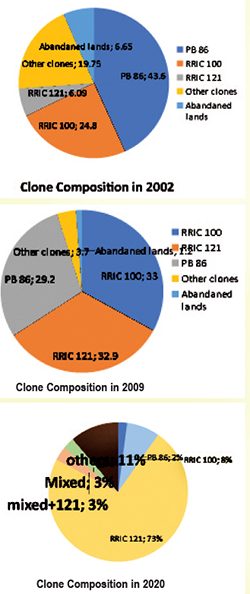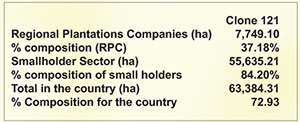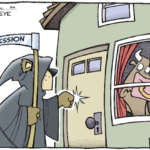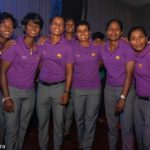A divine intervention needed to save rubber industry-by J. A. A. S. Ranasinghe

Source:Island
Former Director of Rubber Research Institute (RRI), Dr. L. M. K. Tillekeratne’s article in The Island of 26 October, has dealt with several core issues that have contributed to the near collapse of the rubber industry in the country. The importance of clone balancing appears to have escaped the attention of the stakeholders. His piece has not only aroused much public interest but also served as an indictment of the Rubber Development Department (RDD) and the Ministry of Plantation Industries (MPI).
Rationale for clone balancing
Clone balancing means that a country at any given time should have a basket of different clones more than five for the survival of the rubber plantations.
The RRI has asked all stakeholders (Regional Plantation Companies (RPCs), large plantations and smallholders) to abide by the recommended composition of different varieties of clones without depending on one or two clones countrywide as an insurance against possible losses on account of plant diseases. History shows the enormous losses countries have suffered due to their dependence on a few clones. In 1977, clone RRIC 100 was withdrawn as it accounted for more than 40% of the rubber cultivation. Similarly, clone PB 86 was withdrawn twice in 1983 and 1989. With this aim in mind, the RRI periodically prescrib

es the healthy and proper balance of clones to be maintained for the survival of the rubber plantations.
The former RRI Director has stressed the advisability of having a series of recommended clones so that rubber plantations could be commercially run on a profitable basis.
An analysis of the above three scenarios would show a startling deterioration trend. Had a pathogen attacked the rubber plantations in 2002 approximately 68.4% (PB 86 – 43.6%) and RRIC 100 (24.8%) of the Sri Lankan rubber plantations would have been wiped out, leaving a meagre hectarage of 42.6% of the plantations. This disastrous situation had been more or less the same if a pathogen attacked RRIC 100 and RRIC 121 clones, thus destroying 65.9% of the entire rubber plantations. However, the current scenario in 2020 is much graver in that 73% of the rubber plantations with the same clone (RRIC 121) will face a calamitous situation. In the case of RRIC 121, smallholders will be the worst affect as they have cultivated 55,635 hectares with RRIC 121 and as a percentage it would be around 54.20% as per the following table.
The inevitable result of this situation would be that approximately 450,000 employees would lose their employment, and such an eventuality will lead to social unrest amidst a pandemic. It behoves the main stakeholders namely Ministry of Plantation Industries
, Rubber Development Department, Regional Plantations Companies, Rubber Research Board, Rubber smallholders to be fully awake to this situation and comply with the guidelines on clone balancing criteria as well as other best agricultural practices stipulated by the RRI.
All nurseries managed by the Regional Plantation Companies (RPCs), Rubber Development Department (RDD) and Private sector Nursery Owners are periodically inspected by the RRI to ensure that they meet the quality standards and also to ensure that such nurseries abide by the clone balancing stipulated by the RRI.
The fact remains that RPCs, RDD and private sector nursery owners have not strictly adhered to the basket of specific clones advocated by the RRI. Both RDD and private nurseries are primarily responsible for the issue of plants to the smallholders and they are duty bound to issue plants in keeping with the RRI specifications. It is abundantly clear that this requirement has not been complied with. How come the rubber smallholders have cultivated an excessive hectarage of 55,635 with a single clone of RRIC 121, covering an extent of almost 84.20% of the cultivation as seen above. If a leaf disease attacks this clone, total extent of rubber of 46,355 ha will have to be destroyed. It is unfortunate that our stakeholders have not realised this situation.
As Dr. C. S. Weeraratna, former Director of the Advisory Services of the Rubber Research Board has pointed out the country will have to forego an annual foreign exchange loss of Rs. 4.920 million. Can the country afford a loss of this magnitude at this juncture?
The blame for this sorry state of affairs should be placed at the doorstep of the RDD, which is responsible for the issue of plants to the smallholder sector. The Director General (DG) of the RDD is an Ex-Officio of the Rubber Research Board and he interacts with the RRI on clone balancing amongst any other matters and why he had ignored an important requirement involving the life and death of the rubber plantation is a moot point.
Although the RRI is responsible for supervising the nurseries managed by the RDD, it has limited access to the private rubber nurseries managed by the RDD. The private rubber nursery owners have a system of sub-con
tracting nurseries with hardly supervision. If one visits Ruwanwella, Dehiowta, Yatiyantota in the Kegalle District, one can see more than 1,000 individual nurseries sub-contracted by the RDD. It is a mere business for them. They are completely unaware of the clone balancing aspects to be maintained. The clone balancing has already gone out of control of the RRI.
The writer is of the view that the responsibility for managing all nurseries should be taken over by the RRI. The scientists of the RRI are quite capable of handling this task more scientifically. It is relevant to place on record that RRI was given the task of managing the nurseries that were managed by RDD in 2002, when the government decided to close down the RDD. With the change of the government in 2004, this decision was reversed and the task of managing the nurseries was entrusted to RDD at the behest of the bureaucracy, disregarding all the scientific advice. We are
where we are today, as a result.

Both Ministry of Plantation and Rubber Development Department have been in a deep slumber for many years without taking proactive measures to overcome this situation. Many articles that have appeared in The Island during the recent years should have galvanised the authorities concerned into action. All smallholders of the rubber growing districts sent more than 60 representatives to Parliament at the last general election, believing in assurances given in election manifestos, but these MPs done precious little to protect the rubber industry. Rubber smallholders are of the view that at this rate it will be impossible to save the industry without a divine intervention.
Publication of Bulletin on Rubber
The non-publication of the RRI bulletin containing the research findings since 2018 has been a serious lapse on the part of the RRI. My inquiries have revealed that the majority of the scientists have left the institute to join our national universities due to better prospects.
2. From this year onwards RRISL will pay more attention on clone balance while nursery inspection for plant quality improvement.






















